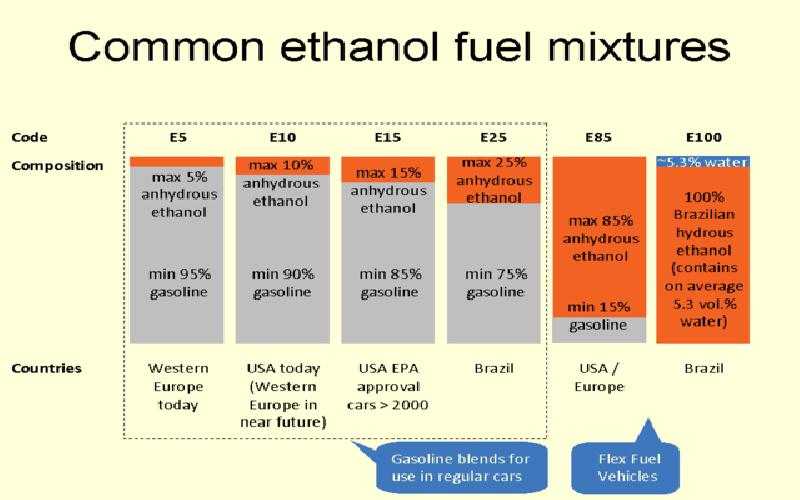Ethanol as fuel
Ethanol or Ethyl Alcohol has been a part of human civilization from ancient times, though not as a transportation fuel. Mankind used it traditionally in the form of drinks and beverages, wines and hard liquor. More recently, with oil reserves running out and oil prices skyrocketing, it has become a substitute of gasoline. Many countries now mandate mixing of 5 to 10 % ethanol with gasoline sold as transport fuel.
The use of ethanol as fuel has lead to many countries increasing their domestic production. Ethanol is produced by two different ways – first is the production from ethylene
obtained from petroleum, while the second is production of ethanol from starch or carbohydrates contained in sugarcane or grains like maize (corn). It is the second type of production – the bio fuel – which is the centre of all attention today and providing as much hope as criticism as a means to solve the oil price riddle.Countries Producing Ethanol
On a global scenario, the two countries leading ethanol production are United States, with approximately 15.3 billion US liquid gallons (bg), and Brazil, with close to 7.3 billion bg. These two countries together accounted for almost 88% of all ethanol production in the world in 2016; which is in line with their consistent domination of global fuel ethanol production during the last decade.
They are followed, at some distance, by the European Union (approximately 1.3 bg), China (approximately 0.8 bg), Canada (around 0.43 bg), Thailand (0.32 bg), Argentina (0.26 bg) and India (0.22 bg). However, a significant chunk of ethanol produced in some of the countries like China and India is not for fuel, and hence they are even less important players so far when it comes to global bio-fuel economy.
Countries of the European Union, with surplus grains that are to some extent, a result of their highly subsidized and efficient mechanized farming, have now taken to production of ethanol as bio-fuel in a big way, and also become one of the major exporters of fuel ethanol. Other newer entrants are countries like Thailand and Colombia where fuel ethanol production has been taken on a large scale. Many other countries, like Australia, Pakistan, Peru, Argentina and Paraguay are also producing significant quantities.
Experience & Strategies of some of the Major Ethanol Producing Countries
BRAZIL
Brazil can be credited as having developed the first real bio-fuel economy in the world. Today, it has an output of around 5 bg of fuel ethanol, accounting for almost one third of all ethanol production and about 42% of all fuel ethanol in the world. It uses sugarcane to make ethanol, using about 3.6 million hectares of land for this purpose, or just about 1% of Brazil’s arable land.
Brazil’s advantage lies in its high productivity, where it is able to produce 7500 litres of ethanol per hectare, compared to about 3000 litres per hectare in United States which uses corn for producing ethanol.
Brazil today has an organised ethanol based transport industry. It is mandatory to have at least 20% ethanol blend in gasoline, called ‘E20’ fuel. However, up to 25% blends are allowed and done in the country. It also has a fleet of three million cars running on Anhydrous Ethanol, a mixture of 96.5% ethanol and 4.5% water instead of gasoline; it also has about five million Flex-Fuel vehicles that can run either on gasoline or anhydrous ethanol.
The success of Brazilian ethanol industry goes largely to sustained policies that began in 1980s, even when the price of crude had
bottomed out. It was given many incentives like low interest loans, guaranteed purchase of ethanol by the state-owned oil company, competitive pricing of retail ethanol to make it competitive and tax incentives on ethanol using vehicles during the 1980s to promote their sale.UNITED STATES
The United States is the biggest fuel ethanol producer; it is also the largest consumer. The major difference between Brazil and United States is that in the latter, corn is used to produce ethanol, which is a far less efficient proposition, and has been blamed the world over for shifting human food to produce fuel – a factor that is cited as having contributed to the rising of food grain prices in the global market.
Within the United States, use of ethanol is equally popular. It is more common in Corn Belt, where ethanol is blended with gasoline in up to 15% proportion. One problem faced is the transportation of bio-ethanol. For this purpose, laying of pipelines is proposed, which will make the use of fuel ethanol more uniform across the whole of United States.
CHINA & INDIA
Both China and India are major ethanol producing countries who have are yet to utilize their full potential in this field.
In China ethanol production and its mandated use is being attempted on a trial basis in five cities of Zhengzhou, Luoyang and Nanyang, Harbin and Zhaodong. In addition, the HENAN province is officially promoting fuel ethanol in the whole province, as part of a strategy to create sufficient demand for ethanol that can let the independent ethanol economy take off.
In India, there is both a demand and a resistance to the use of sugarcane for producing ethanol. On one hand, the farmers lobby for allowing ethanol production from sugarcane, on the other hand consumer organizations and political opposition resist it on the ground that it will lead to rise in sugar prices. Currently, blending of gasoline with 5% ethanol is encouraged and even made mandatory. Efforts are being made to produce ethanol from molasses – a byproduct of sugar industry. In future, that may be the source that most bio-ethanol production in India may depend upon.
The Future of Ethanol production
While Brazil has already become a fuel ethanol dependent economy, other countries are trying to follow suit. United States has made huge strides using corn, but this has given rise to a lot of criticism as well from different quarters. Since ethanol production from corn is far less economically efficient as that from sugarcane, it will be interesting to see how things shape in future. In the meanwhile, countries with less food grain surpluses like India are looking out for other sources like molasses and bio-fuel plants like ‘Jatropa’ that can substitute diesel.
In future, Commercialized Cellulosic Ethanol Production, involving commercial production of ethanol from wood, plants and grass holds immense promise but may take some time before it becomes a reality.
The countries attempting to develop sustainable bio-fuel economies have a lot to learn from the experience of those who have already taken big strides in this direction.










